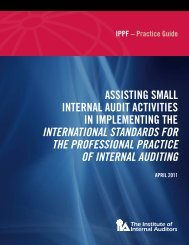2011 State of the Internal Audit Profession Study - PwC
2011 State of the Internal Audit Profession Study - PwC
2011 State of the Internal Audit Profession Study - PwC
You also want an ePaper? Increase the reach of your titles
YUMPU automatically turns print PDFs into web optimized ePapers that Google loves.
“I meet with <strong>the</strong> audit committee chair<br />
regardless <strong>of</strong> whe<strong>the</strong>r <strong>the</strong>re is a formal meeting<br />
coming up and wouldn’t hesitate to pick up <strong>the</strong><br />
phone and call <strong>the</strong> audit committee chair<br />
if I needed to.”<br />
A leading CAE<br />
to internal auditors’ ability to identify<br />
and respond to a broader range <strong>of</strong><br />
risks and continue <strong>the</strong> migration from<br />
financial risks to more operational and<br />
strategic risks.<br />
A common <strong>the</strong>me among <strong>the</strong> CAEs<br />
interviewed was <strong>the</strong> importance <strong>of</strong><br />
relationships and developing a partnership<br />
with <strong>the</strong> business. Gone are <strong>the</strong><br />
days when an annual risk assessment<br />
and a five-year rotational audit plan<br />
was a standard practice in <strong>the</strong> pr<strong>of</strong>ession.<br />
In order for internal audit to<br />
return real value to <strong>the</strong> organization,<br />
today’s audit plans have to be flexible,<br />
responsive, and aligned with company<br />
strategy. Many CAEs have developed<br />
formal relationship management<br />
programs that align <strong>the</strong>ir departments<br />
with <strong>the</strong> business units <strong>of</strong> <strong>the</strong> company.<br />
Those that have been able to engrain<br />
this into <strong>the</strong>ir department’s culture<br />
<strong>of</strong>ten find that <strong>the</strong>ir audit plans are<br />
more demand-driven by <strong>the</strong> business,<br />
as opposed to a supply <strong>of</strong> resources<br />
imposed upon <strong>the</strong> business. They<br />
<strong>of</strong>ten find <strong>the</strong>mselves with a “seat<br />
at <strong>the</strong> table” for important strategic<br />
initiatives. Above all, <strong>the</strong>se CAEs are<br />
Figure 6: Apart from in-person, telephonic, or video-conference audit committee<br />
meetings, how much contact do you have with <strong>the</strong> following individuals?<br />
Frequently:<br />
at least 10<br />
contacts<br />
per year<br />
Periodically:<br />
between 4<br />
and 10 contacts<br />
per year<br />
Occasionally:<br />
fewer than<br />
4 contacts<br />
per year<br />
CFO 80% 12% 5%<br />
Never<br />
Controller 75% 15% 6% 4%<br />
Business unit leaders 62% 28% 8%<br />
CEO 59% 23% 14% 4%<br />
General counsel 59% 21% 11% 9%<br />
CIO 55% 25% 10% 10%<br />
CRO 52% 13% 8% 27%<br />
COO 49% 22% 11% 18%<br />
External auditors 49% 33% 16%<br />
<strong>Audit</strong> committee chair 24% 40% 23% 13%<br />
viewed as leaders in <strong>the</strong> company<br />
and an integral part <strong>of</strong> <strong>the</strong> senior<br />
management team.<br />
Leading CAEs also consider <strong>the</strong> audit<br />
committee as a main component<br />
<strong>of</strong> <strong>the</strong>ir relationship management<br />
programs, interacting with <strong>the</strong>m<br />
frequently outside <strong>of</strong> scheduled meetings.<br />
Establishing a good working<br />
relationship with <strong>the</strong> audit committee<br />
cannot be over-emphasized. Because<br />
internal audit is well-positioned to see<br />
across <strong>the</strong> entire enterprise, it has <strong>the</strong><br />
perspective and <strong>the</strong> objectivity to help<br />
<strong>the</strong> audit committee understand significant<br />
challenges and risks. Those who<br />
invest in relationships and leverage<br />
knowledge across <strong>the</strong> business will<br />
be best positioned to serve <strong>the</strong> audit<br />
committee in this capacity.<br />
Some in <strong>the</strong> pr<strong>of</strong>ession see a potential<br />
conflict between active relationship<br />
building and maintaining auditor<br />
objectivity and independence. Our<br />
belief is that meaningful and sustainable<br />
relationships are built on trust.<br />
For internal auditors, that trust is<br />
built through transparent and candid<br />
dialogue with stakeholders, and<br />
sharing a point <strong>of</strong> view that is not only<br />
fact based but also reflects an understanding<br />
<strong>of</strong> <strong>the</strong> business, its strategies,<br />
and its risks.<br />
Investor relations 21% 19% 24% 36%<br />
<strong>Audit</strong> committee members 11% 35% 33% 21%<br />
External counsel 5% 9% 33% 53%<br />
18 Lights, camera, action… Scripting internal audit for a changed world


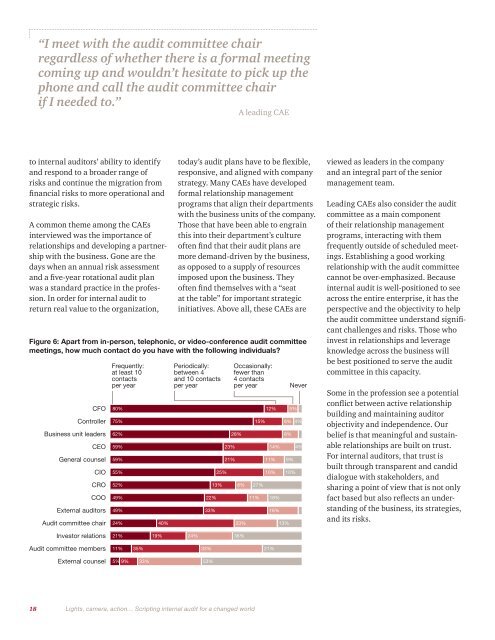
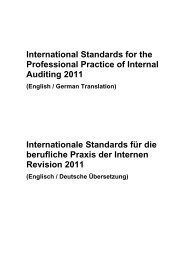

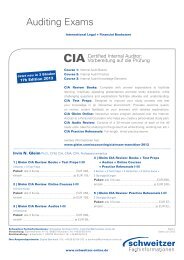
![Ausgabe 02_2011 [PDF, 3.4 MB] - Institut für Interne Revision ...](https://img.yumpu.com/37945857/1/184x260/ausgabe-02-2011-pdf-34-mb-institut-fa-1-4-r-interne-revision-.jpg?quality=85)
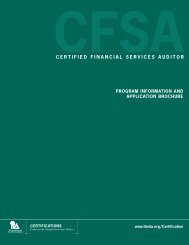
![Ausgabe 2004.2 [PDF, 1.1 MB] - Institut für Interne Revision Ãsterreich](https://img.yumpu.com/37941871/1/184x260/ausgabe-20042-pdf-11-mb-institut-fa-1-4-r-interne-revision-asterreich.jpg?quality=85)
![Ausgabe 02_2009 [PDF, 1.2 MB] - Institut für Interne Revision ...](https://img.yumpu.com/37941824/1/184x260/ausgabe-02-2009-pdf-12-mb-institut-fa-1-4-r-interne-revision-.jpg?quality=85)
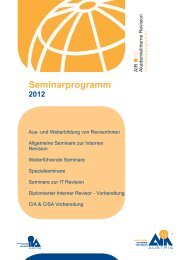
![Ausgabe 03_2011 [PDF, 9.1 MB] - Institut für Interne Revision ...](https://img.yumpu.com/37941423/1/184x260/ausgabe-03-2011-pdf-91-mb-institut-fa-1-4-r-interne-revision-.jpg?quality=85)
![Ausgabe 2006.2 [PDF, 852.7 KB] - Institut für Interne Revision ...](https://img.yumpu.com/37941416/1/184x260/ausgabe-20062-pdf-8527-kb-institut-fa-1-4-r-interne-revision-.jpg?quality=85)
![Ausgabe 03_2007 [PDF, 1.5 MB] - Institut für Interne Revision ...](https://img.yumpu.com/37941405/1/184x260/ausgabe-03-2007-pdf-15-mb-institut-fa-1-4-r-interne-revision-.jpg?quality=85)
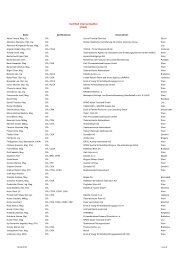
![CEE Konferenzprogramm [PDF, 11.8 MB] - Institut für Interne ...](https://img.yumpu.com/37941387/1/184x260/cee-konferenzprogramm-pdf-118-mb-institut-fa-1-4-r-interne-.jpg?quality=85)
